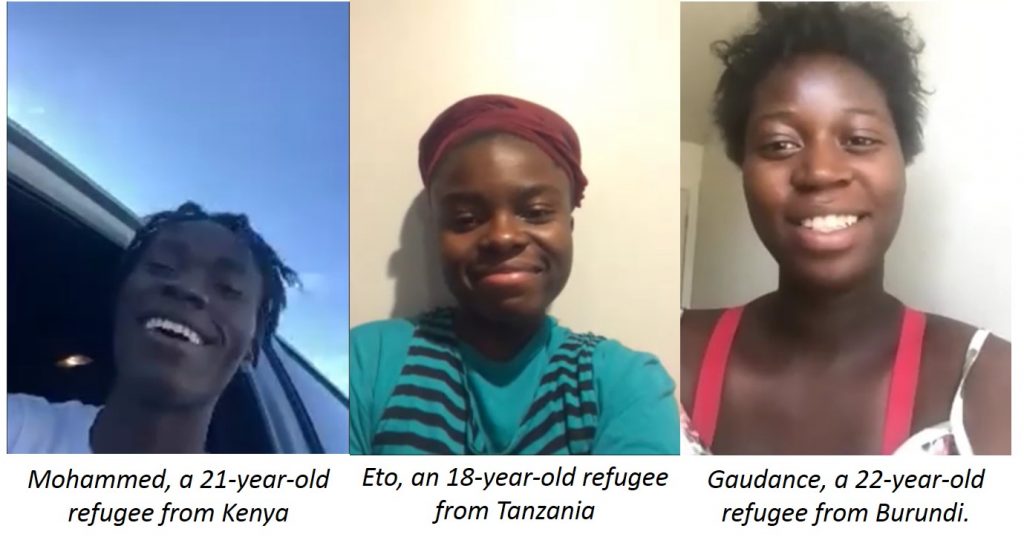 As students are returning to a very unusual school year, Jessica Kallin highlights for www.parenting.digital the experience of refugee students and their families for whom schooling was already very challenging and becomes even more so with limited resources and access.
As students are returning to a very unusual school year, Jessica Kallin highlights for www.parenting.digital the experience of refugee students and their families for whom schooling was already very challenging and becomes even more so with limited resources and access.
Mohammed joins our video call while he’s driving home from work. It’s 30 minutes after our call was supposed to start. I ask him to pull over and he laughs at my concern, but he does. We start talking about his school experience while he hangs out the car window. Mohammed, a 21-year-old refugee from Kenya graduated high school in 2019 after only being in the country a few years. He had the opportunity to have an additional senior year, which gave him the needed time to complete his credit requirements. I ask his thoughts on COVID-19 and online learning while he gets out of the car, and the next few minutes are spent trying to find stable reception in his apartment complex.
It’s been nearly two years since I conducted interviews with refugee youth to discuss the inequities in education they face. At the time, I worked in refugee resettlement in Salt Lake City, Utah overseeing services for nearly 500 youth under the age of 21. In the state of Utah, refugee resettlement agencies provide two years of support upon arrival. As school closures spread through the U.S., I reached out to the same refugee youth, many now high school graduates, to discuss how the abrupt shift to online learning would impact them.
Mohammed squints in the sunlight as he says:
“For new refugees, this will affect them really bad, they don’t know the whole system. Some of them might not know how to use the technology or to do the work. If they don’t have someone close to them, that means they’re not going to do it.”
Mohammed is not alone in this sentiment. In speaking with four refugees who have been in the U.S. for 6-15 years, similar challenges emerge. Dedicated learning space, with device access, internet, and uninterrupted time to focus on schoolwork is an assumed luxury many refugee students don’t have. Coming to the United States without understanding the language and school system, with only a phone as a connection to the internet, makes it hard, COVID-19 makes it harder.
In speaking with two other participants, Eto and Gaudence, they share that technology and access can be a large barrier to understanding. They use their personal cell phones to join our video calls, often losing service or having to move to a quieter location throughout the call. They experience similar difficulties when attempting to learn online. Yet difficulties of access are not only experienced when using physical components of online learning, but also in language, computer literacy, and support systems. Understanding inequities of access, particularly during COVID-19 related school closures demands consideration for students whose daily struggles are often overlooked.
An hour after my scheduled call with Eto, I get a Facebook message saying her phone was taken away, but she has it back now. Her smile is huge as the video connects. Eto is 18 years old and was resettled in the United States from Tanzania in 2014. As she proudly tells me about her recent YouTube graduation ceremony, we reminisce about her start of seventh grade and the difference with her senior year being online. Eto shares difficulties with assignments shifting online, particularly noting the continued need for teacher support:
“Reading all the instructions, you may see there’s long pages, and there’s some words you don’t understand, and you need help with it, and you won’t really get help. You may google the words and you don’t really understand, and you don’t really comprehend what the real word is. You need someone to explain it to you.”
Gaudence was resettled from Burundi when she was in fourth grade and is now 22. She graduated high school and had a baby while starting community college. As we connect on the call, she’s quieting her second child who was just recently born. She echoes Eto’s concerns, saying that the hardest part of online learning is not having someone available to help. She talks about her siblings who are still attending school and the challenges she sees, while sharing that she even doesn’t have a computer and has to use her phone for this call. She says:
“Once they [the school] left the packets there, the kids weren’t motivated enough to do their work at home by themselves. Because 1, the parents didn’t know how to help them with it and the kids didn’t know what to do and 2 they didn’t have any resources for where they could get help or how they can do it, so it didn’t go so well, not as well as it should have went.”
 Trying to navigate the complexities of school requirements is a major challenge. Teachers may not realize the difficulties refugee parents face as they can be preliterate, new to technology, and trying to ensure the school provided device is shared between many children. Gaudence talks about her mother and says:
Trying to navigate the complexities of school requirements is a major challenge. Teachers may not realize the difficulties refugee parents face as they can be preliterate, new to technology, and trying to ensure the school provided device is shared between many children. Gaudence talks about her mother and says:
“She feels like she can’t really help them, and she doesn’t know the skills to do it. When they bring their homework, all she does, all she can do is say ‘hey your teacher has told you to do your homework, make sure you guys do it’ and the kids when they try to do it say ‘I don’t know what to do here’ and they get frustrated and they get angry.”
With school closures, parents are expected to take responsibility for their children learning at home. When parents are unable to participate due to language, work, transportation, or lack of resources, children may not be able to keep up with their classmates. This leads to further lack of inclusion, loss of community, and a higher value on those who understand the education systems. Throughout the conversations, there’s a common message of resilience and support. Offering advice, Eto says:
“I know it’s really hard, sometimes I feel like I can’t do this anymore, sometimes I feel like I’m just going to leave, I’m going to fail all my classes, and then I realize, oh, this is the best opportunity that I can get. Let me just keep going, and then I work very hard, I try my best to get there, and then I made it and I hope they do, too.”
While COVID-19 has made learning even more difficult for many student communities, it is crucial to address the inequities of access and time to better serve student populations. The experiences of refugee youth are not homogenous and there is a broad category of challenges to which schools must be sensitive. While the U.S. education system is intended to help students grow and succeed, it does not have the resources to support or nurture the diverse needs of all students. Refugee youth face many barriers in the education system, and often are not given resources or opportunities to share their experiences. We need to cultivate an education system that values and acknowledges different experiences and provides equitable support, access, and opportunities for all students.
Recommendations
- Provide support for students in their home language. For reference, there are upwards of 50,000 refugees living in Utah speaking over 40 different languages. Establishing a tutoring center or tutoring network for recent graduates to tutor other students in their own language could support language and education access.
- Refugee households often share one device between many family members. Throughout the U.S., schools have begun providing devices to narrow the opportunity gap and provision of devices would help refugee students better access their schoolwork and classes, and communicate with teachers and classmates.
- Continuously check in on students who face the barriers of not being familiar with the language, educational expectations, or technology
- In many cases, resources in communities exist (for example, United Way, Big Brothers Big Sisters, Promise South Salt Lake, and Utah Afterschool Network) but are not well known. At the district and city governance level, coordinating these resources could improve access and reach to the students who need them.
Notes
Acknowledgements
I’d like to first thank the participants in this study who so generously shared their insights and experiences. Thank you to the 30,000 Hours Podcast for generously supporting this extension of my MA thesis research and to Monica Bulger for her mentorship and encouragement.
First published at www.parenting.digital, this post gives the views of the authors and does not represent the position of the LSE Parenting for a Digital Future blog, nor of the London School of Economics and Political Science.
You are free to republish the text of this article under Creative Commons licence crediting www.parenting.digital and the author of the piece. Please note that images are not included in this blanket licence.
Photo credits: Featured image: photo by cottonbro on Pexels. In-text images by Jessica Kallin.





